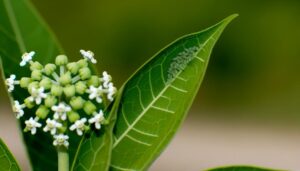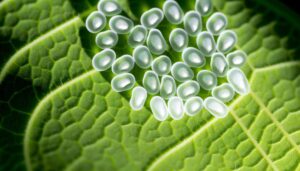5 Stunning Side Views of Monarch Butterflies
A side view of a Monarch butterfly showcases its intricately designed anatomy, essential for its survival. The three primary body segments—head, thorax, and abdomen—are discernible.
The thorax supports two pairs of robust wings featuring a vein framework approximating 2.3 micrometers in thickness, interwoven with scales arranged in overlapping rows. These scales, roughly 100 micrometers in length, contribute to the iconic orange and black coloration, enhancing thermoregulation and predator deterrence.
Compound eyes composed of around 12,000 ommatidia enable broad visual perception. The Monarch's structural nuances reveal evolutionary adaptations significant for flight dynamics and ecological roles, meriting further exploration.
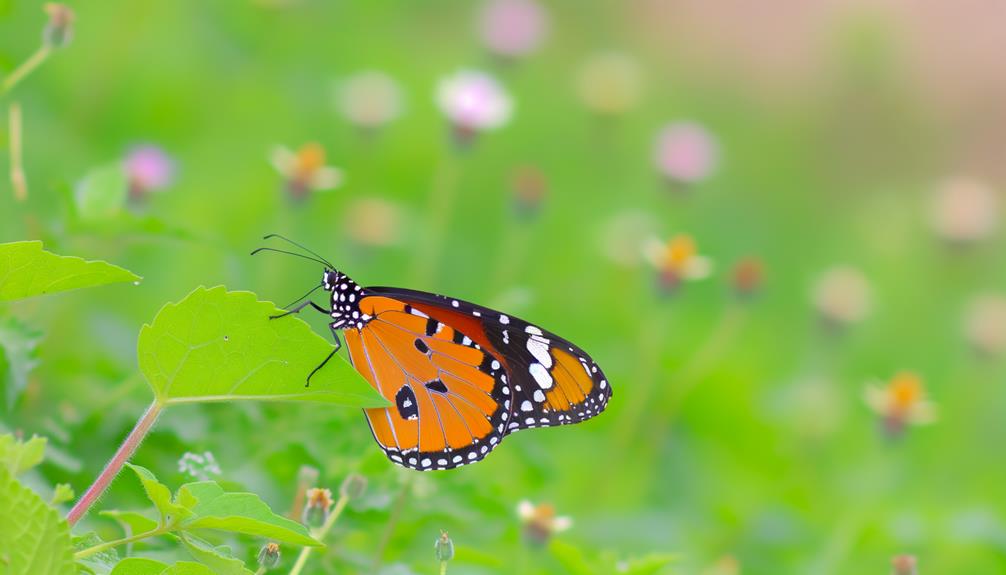
Key Takeaways
- Monarch butterflies display distinctive orange and black wings with intricate scale patterns for thermoregulation and predator deterrence.
- The side view shows two pairs of wings supported by the thorax, with forewings and hindwings featuring a robust vein framework.
- The side view highlights the three main body segments: head with sensory organs, thorax with legs and wings, and abdomen with digestive and reproductive systems.
- Compound eyes, visible on the side, are composed of approximately 12,000 ommatidia, providing a broad field of vision.
Anatomy of Monarch Butterfly
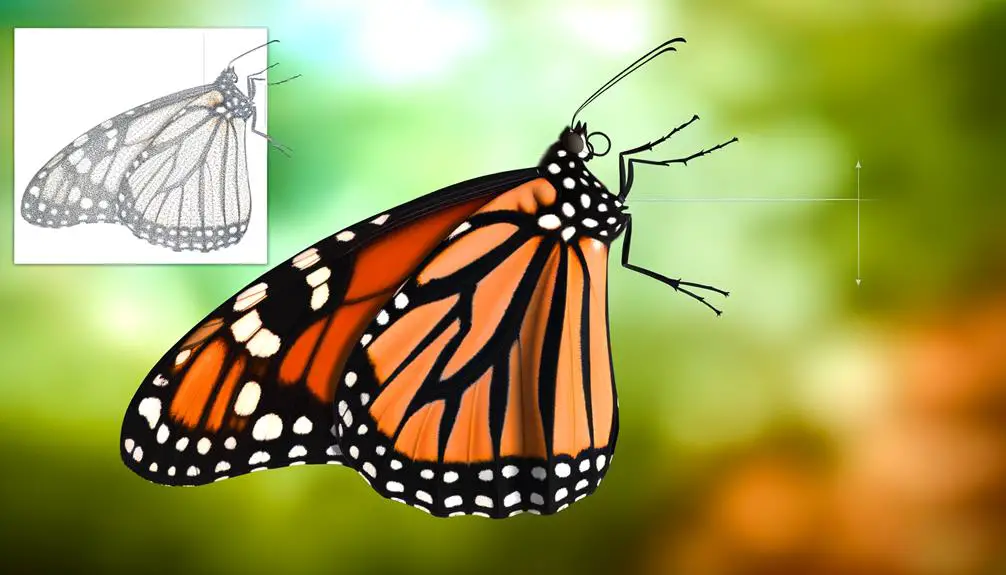
Examining the anatomy of the Monarch butterfly (Danaus plexippus) reveals a complex structure comprising three main body segments: the head, thorax, and abdomen.
The head houses sensory organs including compound eyes, antennae, and proboscis, facilitating navigation, olfaction, and feeding.
The thorax, divided into three segments, supports six legs and two pairs of wings, essential for locomotion. Each thoracic segment is equipped with muscles enabling intricate wing and leg movements.
The abdomen contains digestive and reproductive systems, structured into ten segments, encapsulating critical organs like the Malpighian tubules for excretion and spiracles for respiration.
Detailed morphological studies underscore the Monarch's evolutionary adaptations, emphasizing its intricate physiological mechanisms fundamental for its renowned migratory prowess, therefore embodying a biological marvel of freedom and resilience.
Wing Color Patterns
The wing color patterns of the Monarch butterfly exhibit a distinctive array of orange and black pigmentation, organized into a complex lattice of veins and scales, which serve both functional and signaling purposes. The orange coloration is a result of pigment molecules like beta-carotene, while the black regions are due to melanin. Such pigmentation plays a vital role in thermoregulation and predator deterrence.
| Aspect | Description |
|---|---|
| Pigmentation | Orange (beta-carotene), Black (melanin) |
| Functionality | Thermoregulation, predator deterrence |
| Structural Layout | Complex lattice of veins and scales, optimized for aerodynamic efficiency |
The intricate patterns, including white spots on the black margins, enhance the Monarch's visual signaling, essential for mating and territorial behaviors.
Structural Design
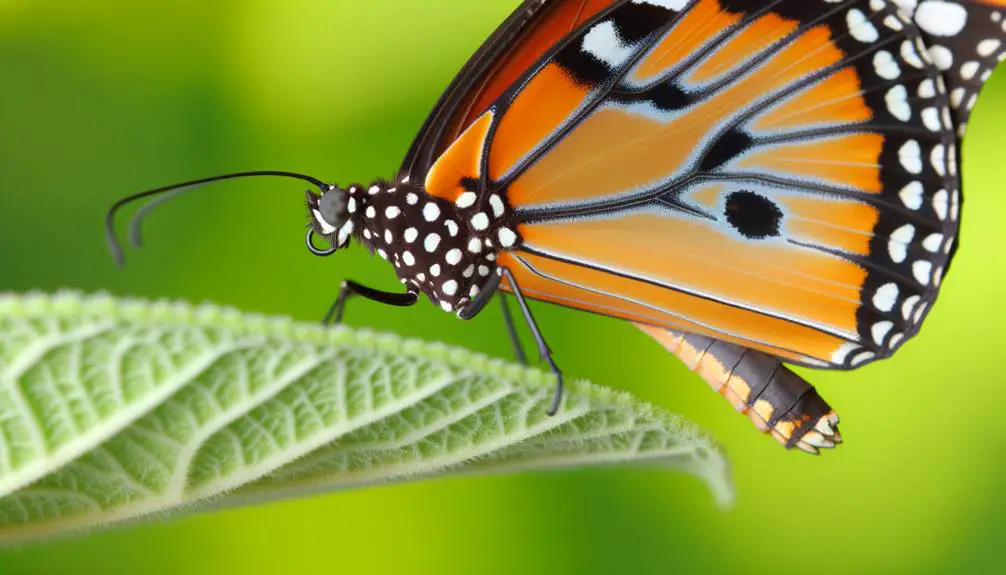
Monarch butterfly wings are composed of a robust framework of veins that provide structural integrity and support for the delicate scale-covered membranes.
These wings exhibit a bifurcated venation pattern, categorized into forewings and hindwings. The veins are primarily longitudinal, interconnected by cross-veins, which enhance rigidity while minimizing weight.
The structural design aids in maintaining aerodynamic efficiency, essential for sustained flight. Detailed studies reveal that the wing's average thickness is approximately 2.3 micrometers, with scales contributing considerably to the overall morphology.
Additionally, the scales are arranged in overlapping rows, creating a mosaic of colors and textures.
This intricate venation system not only facilitates flight dynamics but also plays a pivotal role in thermoregulation and moisture retention, ensuring ideal functionality.
Migration Adaptations
Adaptations essential for the migratory success of Danaus plexippus include enhanced navigational abilities, physiological resilience, and specialized behaviors that facilitate long-distance travel.
Monarch butterflies utilize a time-compensated sun compass and geomagnetic cues to navigate across thousands of kilometers.
Physiologically, they exhibit increased lipid storage, particularly in the form of triacylglycerols, providing crucial energy reserves. Their flight muscles are adapted for sustained, efficient flight, enabling transcontinental journeys.
Behavioral adaptations include diapause, a state of suspended development that conserves energy during migration.
These strategies collectively guarantee that monarchs can traverse diverse and challenging environments, demonstrating remarkable evolutionary adaptations that cater to their migratory lifestyle.
Understanding these mechanisms offers insights into the complex interplay between biological traits and migratory success.
Role in Pollination

Integral to their ecological niche, Danaus plexippus contributes considerably to pollination processes across their migratory range, enhancing floral reproductive success and ecosystem biodiversity. Monarch butterflies utilize their proboscis to access nectar, inadvertently transferring pollen between flowers. This activity facilitates genetic diversity among angiosperm populations and supports trophic dynamics within ecosystems. Data indicates that monarchs visit a variety of plant species, including Asclepias (milkweeds), Solidago (goldenrods), and Aster (asters). Their role in pollination substantiates the importance of conservation efforts aimed at preserving both their habitats and migratory routes.
| Plant Species | Visitation Frequency | Pollination Impact |
|---|---|---|
| Asclepias | High | Significant |
| Solidago | Moderate | Moderate |
| Aster | Low | Minimal |
This symbiotic relationship underscores the delicate balance within natural habitats.
Close-Up of Antennae
A monarch butterfly's antennae, equipped with chemoreceptors, play an essential role in navigation and environmental sensing, enabling the detection of chemical cues and pheromones crucial for survival and reproduction.
These paired structures, typically measuring 10-12 mm in length, are covered with sensilla that enhance their chemosensory capabilities. Research indicates that monarchs use antennal input for migration, detecting volatiles from milkweed and other plants.
Electrophysiological studies reveal that specific neurons within the antennae respond to particular odorous compounds, facilitating host plant identification and mate location.
The antennae's functionality is further underscored by their ability to discern diurnal changes, synchronizing the butterfly's circadian rhythms.
Consequently, the antennae are indispensable for the monarch's ecological interactions and migratory success.
Leg Functionality
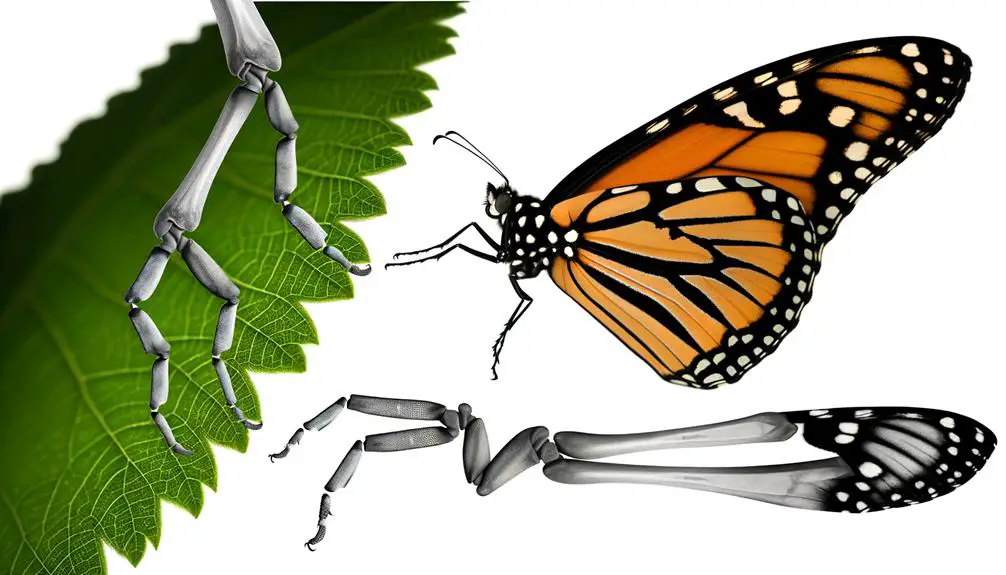
Monarch butterfly legs, each equipped with specialized chemoreceptors and mechanoreceptors, play a significant role in tactile sensing, chemical detection, and environmental interaction. These legs are not merely for mobility; they are sophisticated sensory organs. Chemoreceptors located on the tarsi detect plant compounds, aiding in oviposition site selection. Mechanoreceptors respond to touch, pressure, and vibrations, essential for navigation and predator avoidance. The integration of these sensory inputs enables the monarch to interact dynamically with its environment.
| Leg Segment | Functionality | Special Features |
|---|---|---|
| Tarsi | Chemical detection | Chemoreceptors |
| Femur | Support and movement | Strong muscles |
| Tibia | Sensory input | Mechanoreceptors |
| Coxa | Attachment to thorax | Flexible joint structure |
Such leg functionality underscores the monarch's evolutionary adaptation to its ecological niche.
Eye Structure
The eye structure of the Monarch butterfly (Danaus plexippus) is characterized by large, multifaceted compound eyes composed of approximately 12,000 ommatidia, enabling a broad field of vision.
These compound eyes exhibit heightened sensitivity to ultraviolet light, which plays an essential role in navigation and foraging.
Additionally, adaptations such as polarized light detection enhance the butterfly's ability to maintain stable flight and orientation during long migratory journeys.
Compound Eye Composition
Composed of thousands of individual ommatidia, the compound eyes of a monarch butterfly provide a broad field of vision and are highly efficient in detecting motion. Each ommatidium functions as a separate photoreceptive unit, contributing to a mosaic-like image. The table below elucidates key features:
| Feature | Description |
|---|---|
| Number of Ommatidia | Approximately 12,000 per eye |
| Structure | Hexagonally packed, each with its own cornea and lens |
| Function | Detects light intensity and color, essential for navigation and foraging |
This intricate structure allows monarch butterflies to efficiently process visual information, aiding in their survival and migration. The high density of ommatidia enhances their capacity to perceive rapid movements, a significant adaptation for evading predators.
Vision and Light Sensitivity
Frequently, the intricate structure of a monarch butterfly's compound eyes exhibits a remarkable sensitivity to various wavelengths of light, essential for their survival and migratory behaviors.
Each compound eye comprises approximately 6,000 ommatidia, each functioning as an individual photoreceptive unit. These ommatidia are highly specialized, with different photopigments responsive to ultraviolet, blue, and green light, optimizing the butterfly's capacity to navigate and forage.
Research indicates that monarchs possess a polarization vision, allowing them to detect polarized light patterns in the sky, aiding in orientation during migration.
This sophisticated visual system, coupled with their neural processing capabilities, underscores the monarch butterfly's adaptability to diverse environmental conditions, providing critical insights into their ecological success.
Eye Adaptations for Flight
Considering the aerodynamic demands of sustained flight, monarch butterflies exhibit specialized eye adaptations, such as a high density of ommatidia in their compound eyes, which enhance their ability to detect rapid movements and navigate effectively. These adaptations are vital for their migratory journeys and daily foraging behaviors.
Key structural features include:
- High-resolution imaging: Each compound eye contains approximately 12,000 ommatidia, providing a broad field of vision.
- Polarization sensitivity: Enables detection of polarized light, critical for orientation during long-distance migration.
- Spectral sensitivity: Photoreceptor cells can detect ultraviolet to green wavelengths, aiding in locating nectar sources and mates.
These adaptations collectively support their freedom and survival.
Scales and Texture
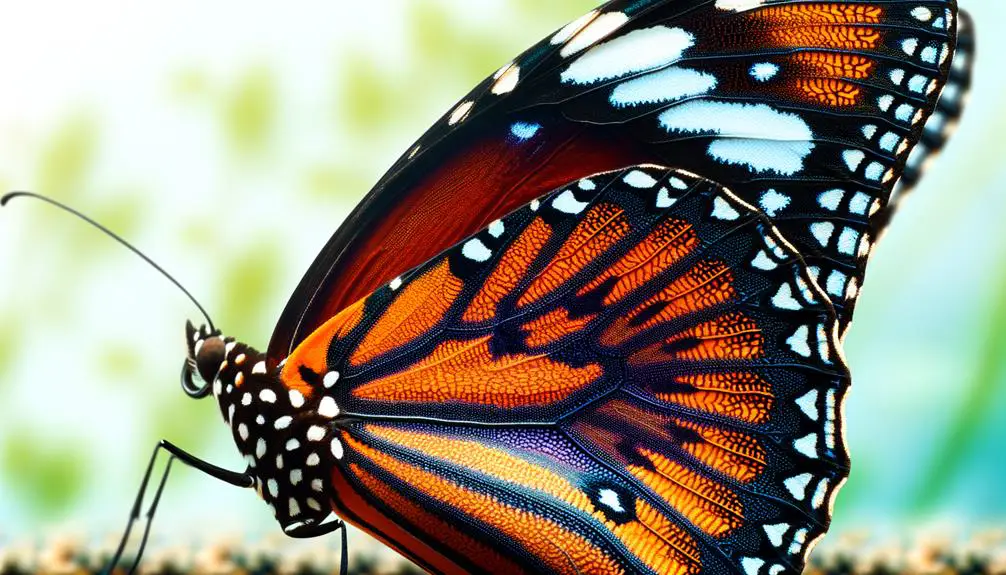
The scales covering the wings of the Monarch butterfly exhibit intricate microscopic color patterns, attributable to the unique arrangement and pigmentation of chitinous scales.
Detailed electron microscopy reveals a highly ordered structural scale arrangement, contributing to the butterfly's vivid coloration and iridescence.
Texture variation traits across different wing regions further enhance the species' adaptive camouflage and thermoregulatory efficiency.
Microscopic Color Patterns
Microscopic examination of monarch butterfly wings reveals intricate color patterns formed by overlapping scales, each contributing to the overall texture and iridescence. These scales, composed of chitin, exhibit a range of hues due to structural coloration and pigment distribution.
Detailed microscopic analysis shows:
- Pigment Granules: Melanin and pterin compounds create the black and orange colors.
- Nano-Structures: Microscopic ridges and lamellae generate iridescent effects through light interference.
- Scale Layers: Multiple overlapping scales enhance color depth and texture.
This multifaceted coloration mechanism not only serves aesthetic purposes but also plays roles in thermoregulation and predator avoidance.
Understanding these microscopic patterns offers insights into the butterfly's adaptive evolution.
Structural Scale Arrangement
Building upon the understanding of microscopic color patterns, the structural arrangement of scales on the monarch butterfly's wings reveals a highly organized and hierarchical system that enhances both visual and functional properties.
Each scale, approximately 100 micrometers in length, is intricately layered in overlapping rows, optimizing light reflection and pigmentation distribution. This arrangement is not random; scales are methodically aligned to maximize aerodynamic efficiency and thermoregulation.
High-resolution imaging demonstrates that the scales' microstructure includes longitudinal ridges and cross-ribs, contributing to their rigidity and lightweight nature. Data indicates that these structural features are critical for sustaining the butterfly's flight dynamics and environmental adaptability.
Such a complex scale architecture underscores the evolutionary ingenuity embedded within the monarch butterfly.
Texture Variation Traits
Variability in texture across the scales of the monarch butterfly manifests through distinct microstructural patterns, influencing both optical properties and tactile sensations. Each scale exhibits unique ridges and grooves, which contribute to their iridescence and color variation.
Detailed microscopic examination reveals the following traits:
- Ridge Density: Variations in the density of ridges affect light diffraction, producing diverse color spectra.
- Scale Thickness: Differences in thickness influence the mechanical strength and flexibility of the scales.
- Pigment Distribution: Uneven pigment distribution enhances visual contrast and camouflage efficiency.
These textural variations are essential for understanding the butterfly's adaptive mechanisms in its natural habitat, allowing for better insights into evolutionary biology and material science.
Flight Mechanism
The flight mechanism of the Monarch butterfly involves a complex interplay of aerodynamic forces, muscular contractions, and wing morphology, enabling efficient and sustained flight over long distances.
Monarchs possess large, flexible wings with a high aspect ratio, optimizing lift and reducing drag. Wing beats, typically at a frequency of 5-12 Hz, are driven by the powerful dorsoventral and longitudinal muscles within the thorax. These muscles facilitate both the upstroke and downstroke phases, essential for generating thrust.
Structural adaptations, such as the presence of microtrichia and scales, enhance aerodynamic efficiency. Data indicates that Monarchs can cover distances exceeding 3,000 miles during migration, demonstrating exceptional endurance and navigational capabilities, critical for their survival and reproductive success.
Monarch Defense Tactics

Monarch butterflies employ a multifaceted suite of defense tactics that include chemical sequestration of cardenolides, aposematic coloration, and behavioral adaptations to mitigate predation risks.
These strategies are essential for survival in their ecological niches. Cardenolides, toxic compounds accumulated from milkweed plants, render monarchs unpalatable to predators. Their bright orange and black coloration serves as a visual deterrent, signaling toxicity to potential threats.
Additionally, monarchs exhibit specific behaviors that reduce predation exposure, such as random flight patterns and nocturnal roosting.
- Chemical Defense: Sequestration of toxic cardenolides from milkweed.
- Aposematic Coloration: Bright orange and black colors warning predators.
- Behavioral Adaptations: Erratic flight patterns to evade predators.
These tactics collectively enhance monarch survivability.
Conclusion
The monarch butterfly, an intricate mosaic of biological marvels, exemplifies nature's engineering through its complex anatomy, vivid wing patterns, and migration adaptations.
Its role in pollination, coupled with unique eye structures and defensive tactics, underscores its ecological significance.
The monarch's scales and textures, akin to a painter's delicate brushstrokes, contribute to its aerodynamic flight mechanisms.
These elements collectively illustrate a finely-tuned organism, seamlessly integrating structure and function within its ecological niche.

